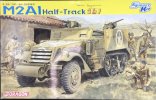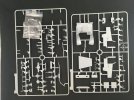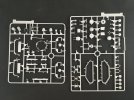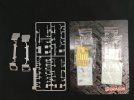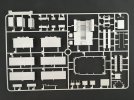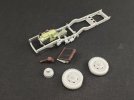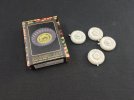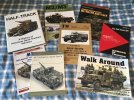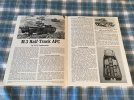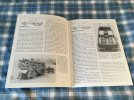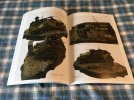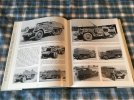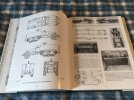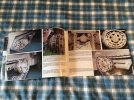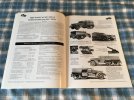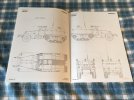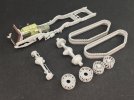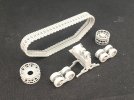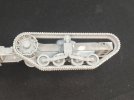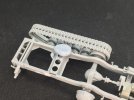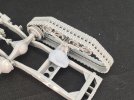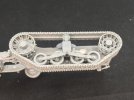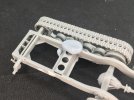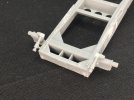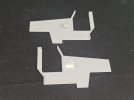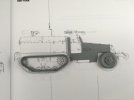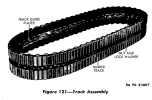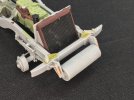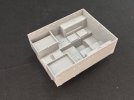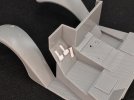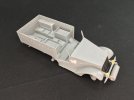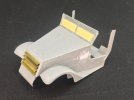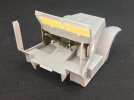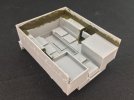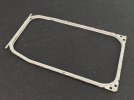- Joined
- Apr 28, 2018
- Messages
- 10,793
- Points
- 113
- First Name
- Jakko
With the M247 nearing the painting stage, my next build is going to be an M2 halftrack, or to give its official designation, a half-track car, M2. It won’t be of any specific real vehicle, but let’s start with some background on the real thing anyway.
In the 1930s, the US Army had been experimenting with half-tracked cars and trucks based on French principles, with an endless rubber-band track (actually rubber vulcanised around steel cables and other parts) around a suspension with a single bogie that usually had four small road wheels, plus a drive sprocket at the front and an idler wheel at the back. Unlike the later German half-tracks, these were relatively uncomplicated vehicles that basically consisted of a common cargo truck in which the rear axle was moved forward to give room for the tracked suspension instead of the normal rear axle and wheels. This T4 half-track truck from 1934 is a good example of the overall kind:
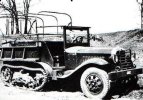
Though they were fairly successful, none seem to have been actually standardised with an M-number, except for the T9 that became the M2 half-track truck:
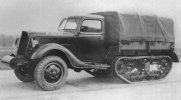
At the same time, the US Army was also developing armoured cars for reconnaissance purposes, adopting the M2 scout car:
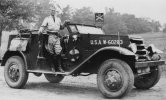
… and then gradually developing that further into first the M3 and then the M3A1 scout car:
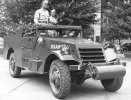
… of which Paul (@scottie3158) is building a model here on the forum. The photo above is an M3A1, by the way — the M3 had a narrower body with external mudguards over the rear wheels, much like on the M2.
The two lines of development were combined to fill a need for armoured half-tracks: the M2A1 scout car was adapted to take a rear tracked suspension taken from that of the T9 half-track truck to produce the T7 half-track personnel carrier:
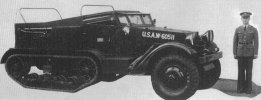
In the very last days of the 1930s, it was decided to use the newer M3A1 scout car as the basis instead, lengthening the rear body and fitting the suspension from the T7 personnel carrier, to produce the T14 half-track scout car:
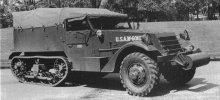
After some modifications, the vehicle was eventually standardised as the M2 half-track car (without “scout”):
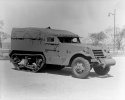
A companion vehicle was also designed, with a slightly longer body, a rear door and a revised interior layout giving more seats, as the M3 half-track personnel carrier:
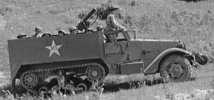
The M2 and M3 are easy to tell apart if you know what to look for. The simplest way is if you can see the interior, as the M3 has five seats along each side in the back, while the M2 has large, rectangular boxes inside behind the cab, with two seats behind them on each side and also two between them (one facing forward and one to the back). If there’s a skate rail around the whole of the interior, with machine guns mounted on it, it’s also an M2, while a pedestal-mounted machine gun in the middle means it’s an M3.
The M3 has a longer body, so if you can’t see the interior, but do see rear mudguards extending beyond the rear plate of the hull, it’s an M2 (though in the field, many M2s were fitted with a large rack on the back to provide stowage space for the crew’s gear, which sat above those mudguards). The M2 also has downward-hinged doors in the hull side, right behind the cab, for access to the lockers inside the rear compartment — so if you can see their outline, latches or hinges, it’s an M2. When fitted with mine racks on the sides (as most of these halftracks were later on), this is even easier, because on the M3 those run all along the hull side, while on the M2 they start behind the locker doors. The M2 has no rear door, so a half-track that lacks that will be an M2 — however, if there is a door, that doesn’t automatically make it an M3, because the M4 mortar carrier had the shorter M2 body but with a rear door. (An M4 is very hard to tell apart from an M2 unless you can see its interior or the rear door, BTW.)
During the war, both were improved in similar ways, mainly in having “A1” variants (M2A1 and M3A1) that added a ring mount for a machine gun, with armour plating around it, over the front passenger’s seat. The M2A1 did not have the skate rail that the M2 did, though, and in the M3A1, the pedestal mount was deleted too.
The M2, M2A1, M3 and M3A1 were built by the Autocar, Diamond T and White companies, while International Harvester adapted the design to their own production methods to create the M5/M5A1 (M3/M3A1-equivalent) and M9A1 (M2A1-equivalent) half-tracks. You can tell them apart by front wings that don’t have a downward turn to them, by the rear corners of the hull being rounded rather than angular, and a bunch of other details, though the M9A1 did not have a shorter body, nor the external doors to the lockers (in fact, an M9A1 is totally impossible to tell from an M5A1 unless you can see the interior). All of them would be widely used in the Second World War, though because of the large differences between the M2/M3-series on the one hand and the M5/M9-series on the other, the latter were mostly assigned to Lend-Lease (chiefly to the UK and USSR), and only used in very small numbers by American forces.
In the 1930s, the US Army had been experimenting with half-tracked cars and trucks based on French principles, with an endless rubber-band track (actually rubber vulcanised around steel cables and other parts) around a suspension with a single bogie that usually had four small road wheels, plus a drive sprocket at the front and an idler wheel at the back. Unlike the later German half-tracks, these were relatively uncomplicated vehicles that basically consisted of a common cargo truck in which the rear axle was moved forward to give room for the tracked suspension instead of the normal rear axle and wheels. This T4 half-track truck from 1934 is a good example of the overall kind:

Though they were fairly successful, none seem to have been actually standardised with an M-number, except for the T9 that became the M2 half-track truck:

At the same time, the US Army was also developing armoured cars for reconnaissance purposes, adopting the M2 scout car:

… and then gradually developing that further into first the M3 and then the M3A1 scout car:

… of which Paul (@scottie3158) is building a model here on the forum. The photo above is an M3A1, by the way — the M3 had a narrower body with external mudguards over the rear wheels, much like on the M2.
The two lines of development were combined to fill a need for armoured half-tracks: the M2A1 scout car was adapted to take a rear tracked suspension taken from that of the T9 half-track truck to produce the T7 half-track personnel carrier:

In the very last days of the 1930s, it was decided to use the newer M3A1 scout car as the basis instead, lengthening the rear body and fitting the suspension from the T7 personnel carrier, to produce the T14 half-track scout car:

After some modifications, the vehicle was eventually standardised as the M2 half-track car (without “scout”):

A companion vehicle was also designed, with a slightly longer body, a rear door and a revised interior layout giving more seats, as the M3 half-track personnel carrier:

The M2 and M3 are easy to tell apart if you know what to look for. The simplest way is if you can see the interior, as the M3 has five seats along each side in the back, while the M2 has large, rectangular boxes inside behind the cab, with two seats behind them on each side and also two between them (one facing forward and one to the back). If there’s a skate rail around the whole of the interior, with machine guns mounted on it, it’s also an M2, while a pedestal-mounted machine gun in the middle means it’s an M3.
The M3 has a longer body, so if you can’t see the interior, but do see rear mudguards extending beyond the rear plate of the hull, it’s an M2 (though in the field, many M2s were fitted with a large rack on the back to provide stowage space for the crew’s gear, which sat above those mudguards). The M2 also has downward-hinged doors in the hull side, right behind the cab, for access to the lockers inside the rear compartment — so if you can see their outline, latches or hinges, it’s an M2. When fitted with mine racks on the sides (as most of these halftracks were later on), this is even easier, because on the M3 those run all along the hull side, while on the M2 they start behind the locker doors. The M2 has no rear door, so a half-track that lacks that will be an M2 — however, if there is a door, that doesn’t automatically make it an M3, because the M4 mortar carrier had the shorter M2 body but with a rear door. (An M4 is very hard to tell apart from an M2 unless you can see its interior or the rear door, BTW.)
During the war, both were improved in similar ways, mainly in having “A1” variants (M2A1 and M3A1) that added a ring mount for a machine gun, with armour plating around it, over the front passenger’s seat. The M2A1 did not have the skate rail that the M2 did, though, and in the M3A1, the pedestal mount was deleted too.
The M2, M2A1, M3 and M3A1 were built by the Autocar, Diamond T and White companies, while International Harvester adapted the design to their own production methods to create the M5/M5A1 (M3/M3A1-equivalent) and M9A1 (M2A1-equivalent) half-tracks. You can tell them apart by front wings that don’t have a downward turn to them, by the rear corners of the hull being rounded rather than angular, and a bunch of other details, though the M9A1 did not have a shorter body, nor the external doors to the lockers (in fact, an M9A1 is totally impossible to tell from an M5A1 unless you can see the interior). All of them would be widely used in the Second World War, though because of the large differences between the M2/M3-series on the one hand and the M5/M9-series on the other, the latter were mostly assigned to Lend-Lease (chiefly to the UK and USSR), and only used in very small numbers by American forces.
Last edited:

 Some years ago, I bought this kit second-hand:
Some years ago, I bought this kit second-hand: